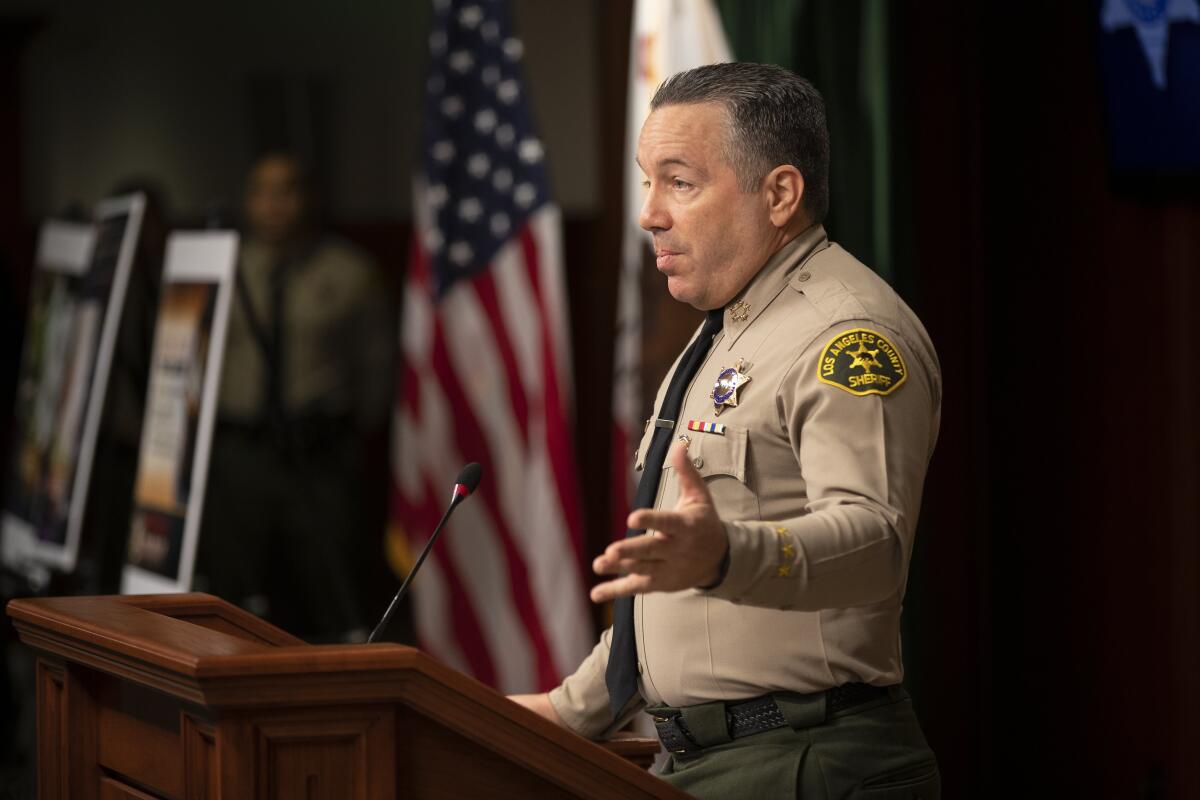Can L.A. County supervisors remove Sheriff Villanueva? Experts say the options are limited

The bitter discord among Los Angeles Countyâs top elected leaders ramped up a notch this week with a push by two supervisors to explore what it would take to remove Sheriff Alex Villanueva from his elected position.
The Board of Supervisorsâ vote on the matter was postponed by two weeks. Questions remain, though, about whether the board has the power to force Villanueva out or whether the proposal is more of a symbolic gesture to pressure him as he faces mounting calls to resign.
The answers are complicated, and Villanueva has suggested he would challenge any effort to remove him.
Supervisor Mark Ridley-Thomas â who wrote the proposal in one of his last moves before next weekâs election, in which heâs running for a City Council seat after serving the maximum 12 years on the board â said itâs still worth at least looking into.
âWe will not be able to do that if we donât try,â he told The Times. Ridley-Thomas and Supervisor Sheila Kuehl, who co-wrote the motion, have criticized Villanuevaâs failure to cooperate with the Office of Inspector General, which oversees the Sheriffâs Department, and echoed calls for his resignation.
âIt has become increasingly clear that the sheriffâs blatant disregard for transparency and accountability requires a more forceful response,â their motion says.
Villanueva has said that he has no plans to quit and that supervisors looking to undo the results of a lawful election could trigger a legal battle that would cost millions of dollars.
âLetâs set aside the past and work out our differences,â he told the board Tuesday, offering a more conciliatory tone than usual. He blamed the chief executive office, though, for not funding positions to comply with an âavalancheâ of records requests under a new transparency law that made some internal police records public.
âTransparency and accountability do not come cheap,â he said.
Legal and governance experts said there are limited options in removing an elected officer short of a recall or their committing a crime.
âThere are plenty of checks and balances already in place,â said former L.A. County Dist. Atty. Steve Cooley. âThe only way that some of these harebrained ideas will ever reach fruition is if the [state] Constitution is changed. ⌠If they change the Constitution, that would impact every single one of Californiaâs 58 elected sheriffs.â
âWhen youâre elected, it means something,â said Frank V. Zerunyan, a professor on the practice of governance at USC. Villanueva âwas elected â heâs using the Constitution to his favor, rightfully so, to be honest. I canât blame him for saying what heâs saying.â
But there is case law as well as an old state attorney general opinion that suggests thereâs a way to remove an elected sheriff in California, said Mario Mainero, a law professor at Chapman Universityâs Fowler School of Law.
In 2001, then-California Atty. Gen. Bill Lockyer concluded that a county charter may grant the board of supervisors the authority to remove the sheriff, district attorney or other county officer for cause with a four-fifths vote.
The opinion was cited by a California appeals court in 2005 when it declared constitutional an ordinance approved by the San Bernardino County Board of Supervisors that allowed them to remove a sheriff for certain reasons â including flagrant or repeated neglect of duties, misappropriation of public property, violation of any law related to the performance of the officialâs job duties or willfully falsifying an official document â with a four-fifths vote.
âIt makes it very clear that the board then has the power to remove, but is also clear they cannot remove for performing law enforcement functions,â Mainero said. âThey cannot be doing this because they have a disagreement with the manner of performing law enforcement functions. Theyâre going to have to do it based on something other than that.â
A sheriffâs refusal to comply with subpoenas or oversight laws could be justification for his removal, Mainero said. Villanueva, however, would have to argue those actions interfered with his law enforcement duties.
âHeâs got to make that argument, because thatâs his only argument,â Mainero said. âBut it doesnât mean itâs true, and it doesnât mean itâs not true.â
A judge would have to decide âwhether or not thatâs a pretext by him or whether this really is an interference,â Mainero said.
In San Bernardino County, the Board of Supervisors never actually tried to remove the sheriff, said county spokesman David Wert. That case, he said, began in 2002 when officials noticed a provision on the countyâs charter that gave the board the power to do so without any standards or process, âleaving it vulnerable for abuse.â
So the board created the ordinance, which then-Sheriff Gary Penrod challenged, arguing that it conflicted with the Peace Officers Bill of Rights and his independence under state law, Wert said. The appellate court didnât weigh in on the Bill of Rights argument in its 2005 decision.
The ordinance says that the removal of an elected county officer âis an extraordinary act and should occur in only the most egregious of circumstances and only when the interests of the citizens of the county cannot be reasonably served by any other means. These circumstances include the exposure of the county, or its employees, to irreparable harm.â
The proposal in Los Angeles County drew criticism from Ron Hernandez, president of the Assn. of Los Angeles Deputy Sheriffs, the union that represents rank-and-file deputies.
âAs far as the board motion, I think they are blinded by their frustration and focused on the personality conflict instead of the safety of their communities,â he said. âAny elected body who is focused on finding a way to override the voters has lost touch with the constituents they serve.â
Ridley-Thomas postponed the discussion and vote to Nov. 10, saying he wanted his colleagues on the board to have more time to review the motion. Already, there was some pushback.
âI still stand by my belief that the sheriff is elected,â said Supervisor Kathryn Barger, who opposes the motion. âAnd that, in 2022, unless thereâs a community-led effort to vacate that seat prior to that, that thatâs where the voters have a right.â
Times staff writer Jaclyn Cosgrove contributed to this report.
More to Read
Sign up for Essential California
The most important California stories and recommendations in your inbox every morning.
You may occasionally receive promotional content from the Los Angeles Times.










